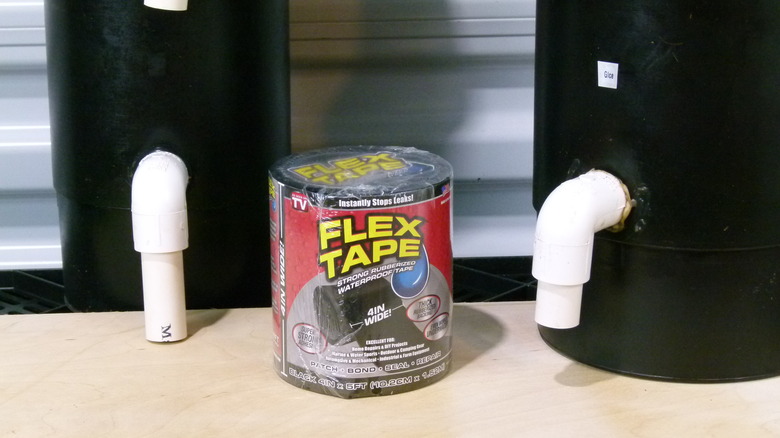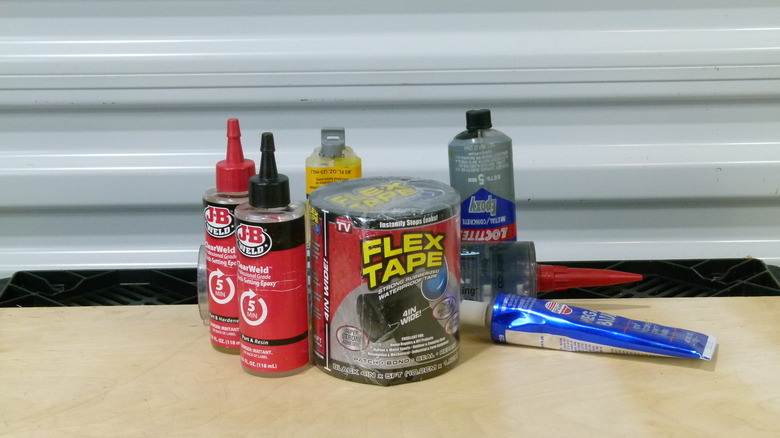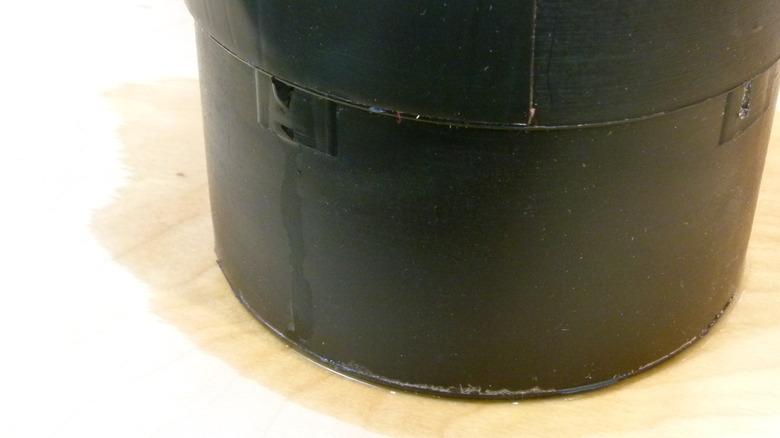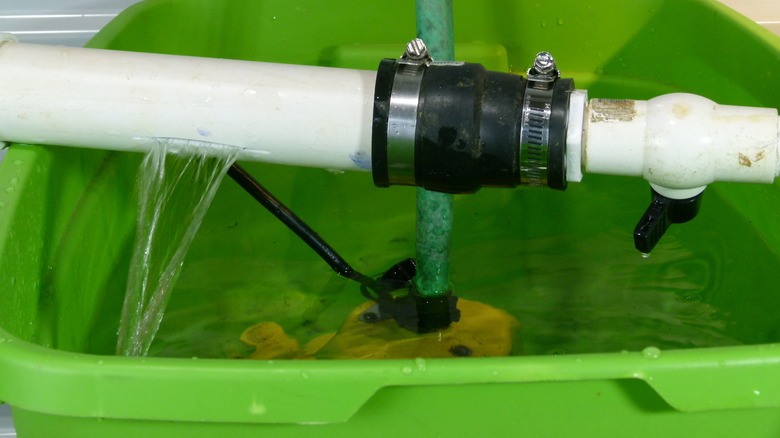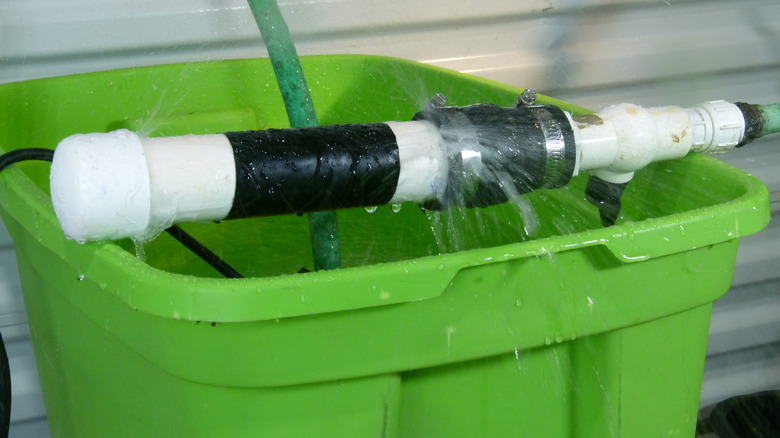We Tried The As-Seen-On-TV Water-Proof Flex Tape
We didn't buy our $14.87 roll of Flex Tape after watching a TV ad (we braved a local Walmart). Still, it's easy to see why many people have: The stuff appears to do something amazing, and the bombastic spokesperson is a pitch-perfect pitchman for something unbelievable. As he's slapping a patch on a leaking tank or riding around in a boat held together with tape, you get the sense that he's genuinely excited about the product.
As-seen-on-TV products require a balancing act, managing both the unseemly business of attention-grabbing while overcoming natural concerns about the quality of products hawked in loud, obnoxious TV commercials. This appears to be the boat Phil Swift, the Flex Seal spokesperson, is in. And Phil gets in a lot of boats. He's famous for using his company's products to repair boats he's sliced in half or cut enormous holes in. Since then, he's become just plain famous. (There is a petition to make Phil Swift the new face of Papa Johns, a Spotify album and track called "Phil Swift" by the Dixie High Men's Bathroom Choir, parody videos on YouTube, and more memes than you can shake an angle grinder at.)
Phil is great at hyping Flex Tape and his other products, which have fairly strong reputations. The real question is how much hype about them is accurate and how much boils down to kooky infomercial-style hijinks.
What is Flex Tape, and why is that man shouting about boats?
Flex Tape's promise is encapsulated in that boat Phil Swift cut in half and stuck back together: It's about waterproofness and strength. There are a lot of products on home center shelves designed to stick wet things together or plug holes to keep water on one side of a repair. Rummaging through drawers here, we came up with well over a dozen such rolls of tape, tubes of adhesive, and cartridges of caulk and sealant. They tend to cost about the same as Flex Tape (as with Gorilla Waterproof Patch & Seal Tape), though sometimes less (like Nashua's Aqua-Seal Tape).
There are likely many of these products, at least partly, because none work flawlessly. However, Flex Tape claims to be the one that is strong and waterproof enough to make the others unnecessary. We were hopeful about Flex Tape, as many others have been. However, we set realistic expectations. One unhappy reviewer wrote, "Completely disappointed and unimpressed. I'm glad I only had a leak and didn't cut my boat in half!" Another misunderstood the aluminum boat stunt and decided to attempt to fix a broken aluminum ladder with Flex Tape, which was the most dangerous thing we heard today. Sure, it's strong, but what's strong about it is reportedly its adhesive. Todd Osgood of Project Farm had to stand on his worktable and lift with his legs to get the stuff off a piece of plexiglass.
How to patch a $5 bucket for $15
We revisited Phil Swift's original 2017 Flex Tape commercial to see precisely what he claimed. In the first scene, he famously slaps tape on a large hole in a glass tank, stopping the water immediately. Later, he patches a bucket and another leaking tank ... from the inside, underwater. We happened to have a bunch of buckets sitting around with holes in them, so we recreated the stunt. Actually, they were concrete pipe sleeves used in construction, repurposed for a hydroponics system. The buckets have ⅞-inch holes drilled in them, so we covered one with Flex Tape and filled it with water, pressing the tape firmly without rubbing. Within 10 minutes, a small trickle of water formed a puddle under the form. In case the shape of the pipe sleeve or its PVC composition was the problem, we repeated the test with a storage tote of unknown plastic makeup ... possibly polypropylene or polyethylene.
We had noticed creases in the tape when unrolling it, apparently caused by the rolling itself and the shrink-wrapping. To prevent such a crease from forming a channel for water to escape, we carefully applied the tape to our tote, pressing it thoroughly and then going over it with a vinyl seam roller. After a few hours, there were no leaks at all. We then removed the patch, plugged the hole, refilled the tote, removed the plug, and applied a patch to the inside, which also worked flawlessly.
The inside is completely dry!
Another demonstration from Phil Swift's commercial showed water flowing from a large PVC pipe, likely meant to represent a wastewater pipe under no pressure. We decided to do one better by devising a test rig using schedule 40 PVC and at least some water pressure. We used a table saw to create a kerf-width slit in the pipe, then connected the PVC (via garden hose) to a 1,350-gallons-per-hour Wayne transfer pump. The submersible pump went into our storage tote, which carried 10 gallons of water from the previous test.
We tested the rig without a patch, then applied Flex Tape carefully to seal the slit. It turns out that 1,350 gallons is quite a lot of water to attempt to move through a sealed pipe. This sounds obvious in retrospect, like trying to cross the highway and exclaiming that 65 mph seems pretty fast. In any event, our water had nowhere to go. But water, like earth, wind, and fire, has no intention of getting dressed up and not going out. Water sprayed from the PVC cap on the end of the pipe and from both ends of the rubber coupler we attached to the other end with hose clamps. The test was being conducted indoors to avoid the rain, a goal at which we failed. But the Flex Tape achieved its goals. No water escaped the tape for the 20 frantic seconds during which we raced to turn off the pump.
Our verdict on Flex Tape
Until you peel off the tape's backing, Flex Tape doesn't seem likely to work. It's simple, unreinforced rubber tape. It's not particularly thick, and the backing used to keep the rolled tape from sticking to itself comes off easily, but it sticks to just about anything else. It is, of course, fairly flexible, so it applies easily, conforming to curves of a reasonable diameter without any curling.
The creases we noticed in the tape are troublesome. These would almost certainly become a highway for water egress in the presence of any amount of pressure. But we didn't see any leaks, even under pressure, except the first leak in the concrete pipe sleeve, and this could have been due to some peculiarities of the form's shape or possibly the pigmented PVC it was made of.
Overall, Flex Tape was impressive. Of course, we're under no illusion that it would be an indefinite fix for a pressurized PVC pipe, but it will undoubtedly be what we reach for as a stopgap should any such leak arise. Nor would we use it to piece an aluminum fishing boat back together. But for everyday problems like above-ground pools, keeping water out of conduit, or repairing a toy boat, Flex Tape seems like just the thing.
It's worth mentioning that when we first did the PVC pipe test, our garden hose showed a pinhole leak, which we patched with a 2x2 piece of Flex Tape with no problem.

